instrument panel JEEP PATRIOT 2007 1.G Owners Manual
[x] Cancel search | Manufacturer: JEEP, Model Year: 2007, Model line: PATRIOT, Model: JEEP PATRIOT 2007 1.GPages: 440, PDF Size: 7.26 MB
Page 2 of 440
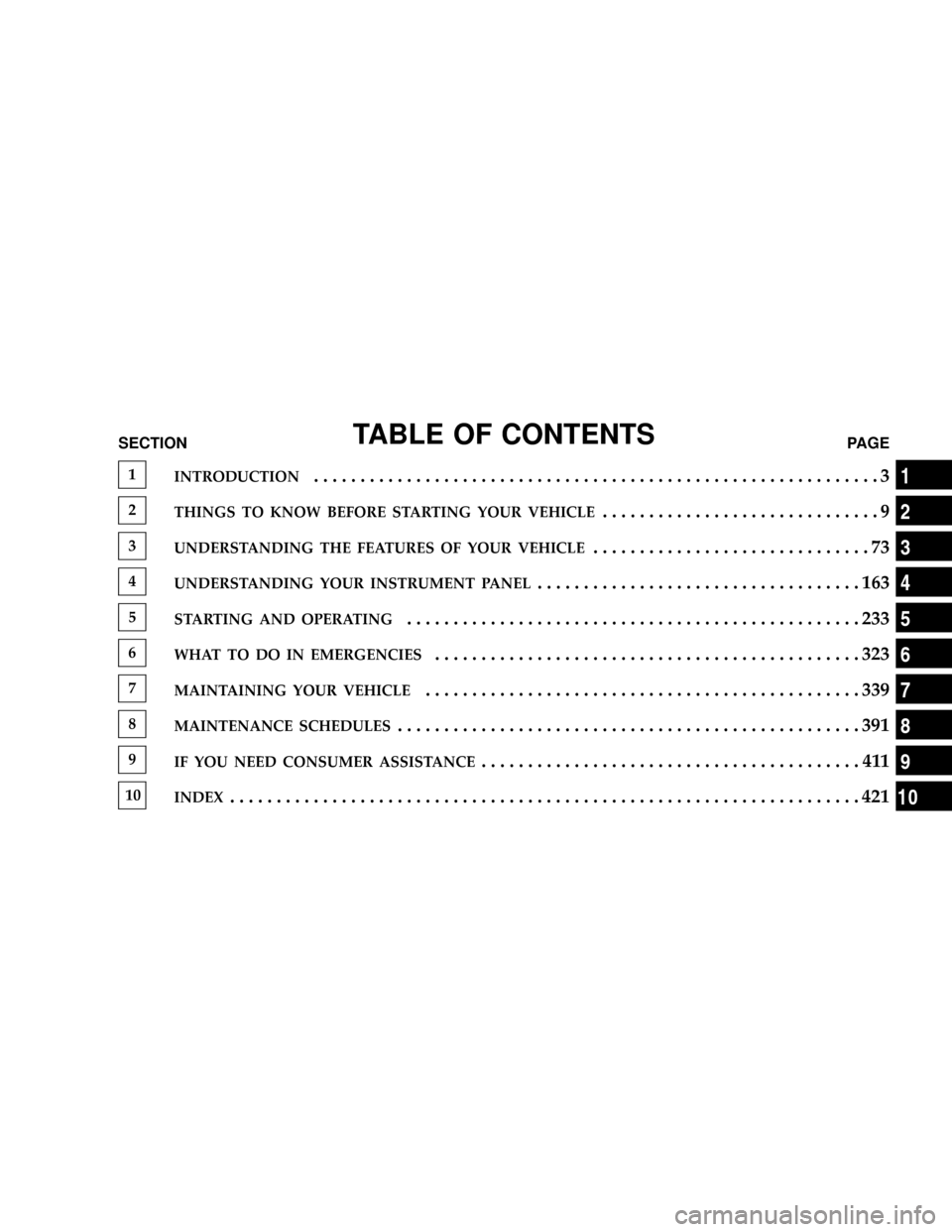
TABLE OF CONTENTSSECTIONPAGE
1INTRODUCTION.............................................................3
2THINGS TO KNOW BEFORE STARTING YOUR VEHICLE..............................9
3UNDERSTANDING THE FEATURES OF YOUR VEHICLE..............................73
4UNDERSTANDING YOUR INSTRUMENT PANEL...................................163
5STARTING AND OPERATING.................................................233
6WHAT TO DO IN EMERGENCIES..............................................323
7MAINTAINING YOUR VEHICLE...............................................339
8MAINTENANCE SCHEDULES..................................................391
9IF YOU NEED CONSUMER ASSISTANCE.........................................411
10INDEX....................................................................421
1
2
3
4
5
6
7
8
9
10
Page 8 of 440
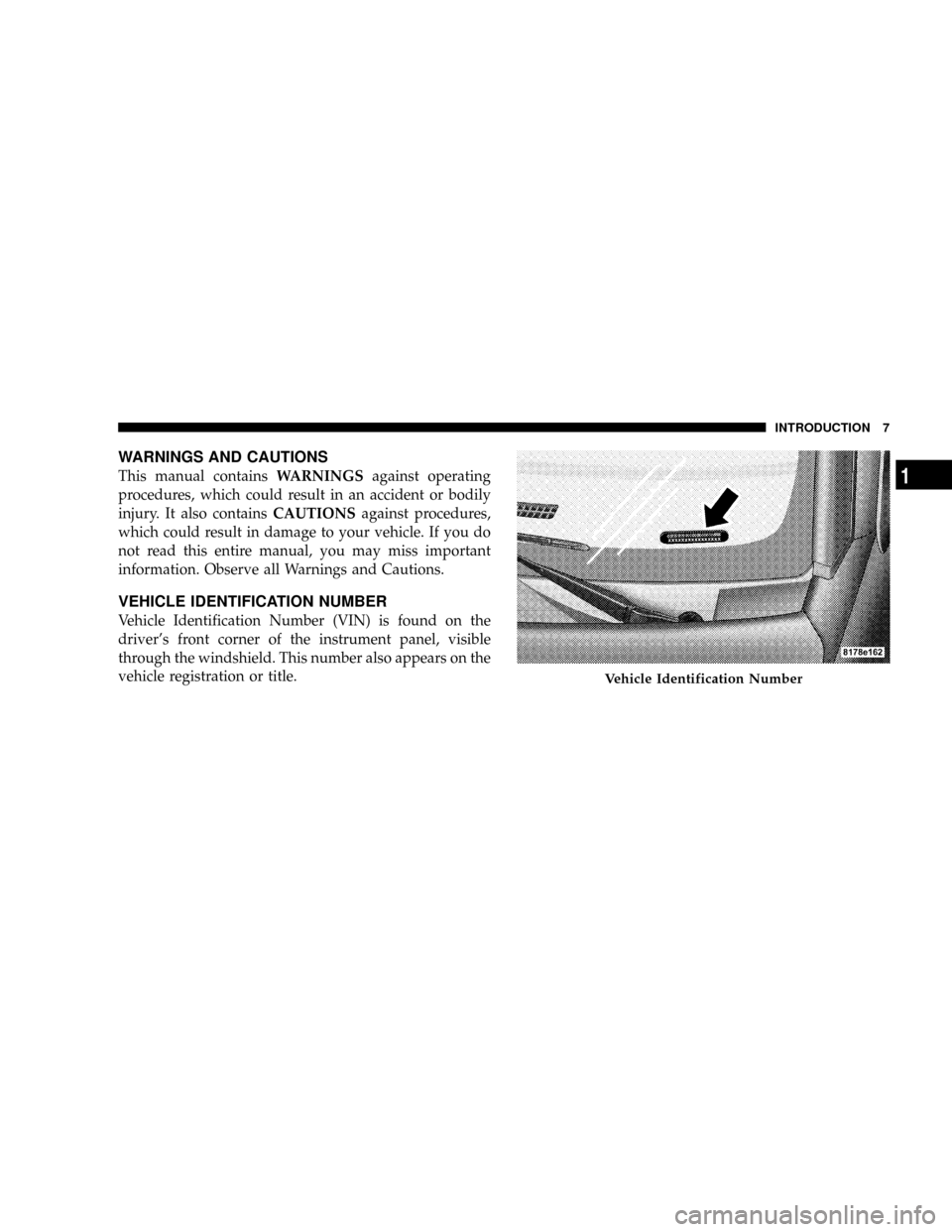
WARNINGS AND CAUTIONS
This manual containsWARNINGSagainst operating
procedures, which could result in an accident or bodily
injury. It also containsCAUTIONSagainst procedures,
which could result in damage to your vehicle. If you do
not read this entire manual, you may miss important
information. Observe all Warnings and Cautions.
VEHICLE IDENTIFICATION NUMBER
Vehicle Identification Number (VIN) is found on the
driver's front corner of the instrument panel, visible
through the windshield. This number also appears on the
vehicle registration or title.
Vehicle Identification Number
INTRODUCTION 7
1
Page 50 of 440
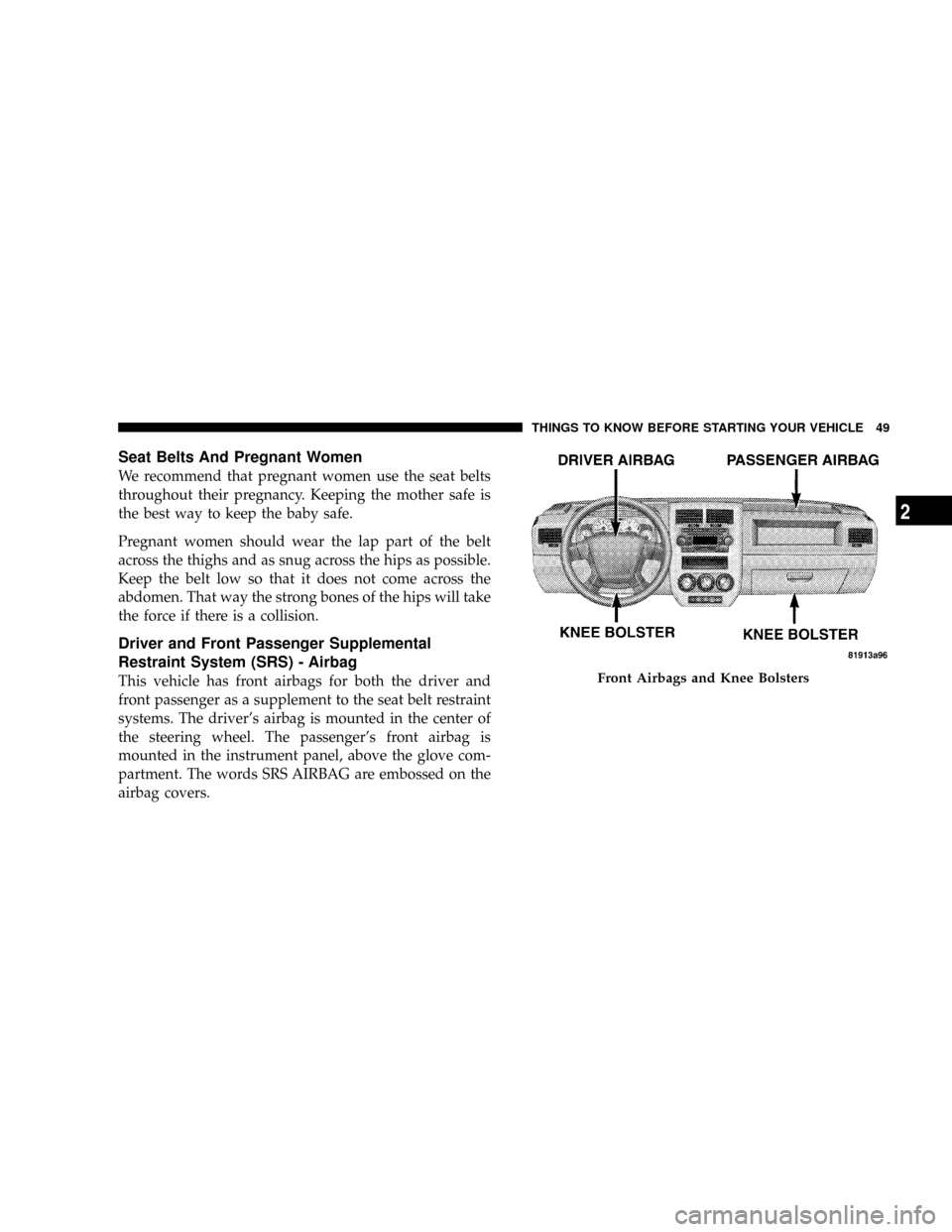
Seat Belts And Pregnant Women
We recommend that pregnant women use the seat belts
throughout their pregnancy. Keeping the mother safe is
the best way to keep the baby safe.
Pregnant women should wear the lap part of the belt
across the thighs and as snug across the hips as possible.
Keep the belt low so that it does not come across the
abdomen. That way the strong bones of the hips will take
the force if there is a collision.
Driver and Front Passenger Supplemental
Restraint System (SRS) - Airbag
This vehicle has front airbags for both the driver and
front passenger as a supplement to the seat belt restraint
systems. The driver's airbag is mounted in the center of
the steering wheel. The passenger's front airbag is
mounted in the instrument panel, above the glove com-
partment. The words SRS AIRBAG are embossed on the
airbag covers.Front Airbags and Knee Bolsters
THINGS TO KNOW BEFORE STARTING YOUR VEHICLE 49
2
Page 52 of 440
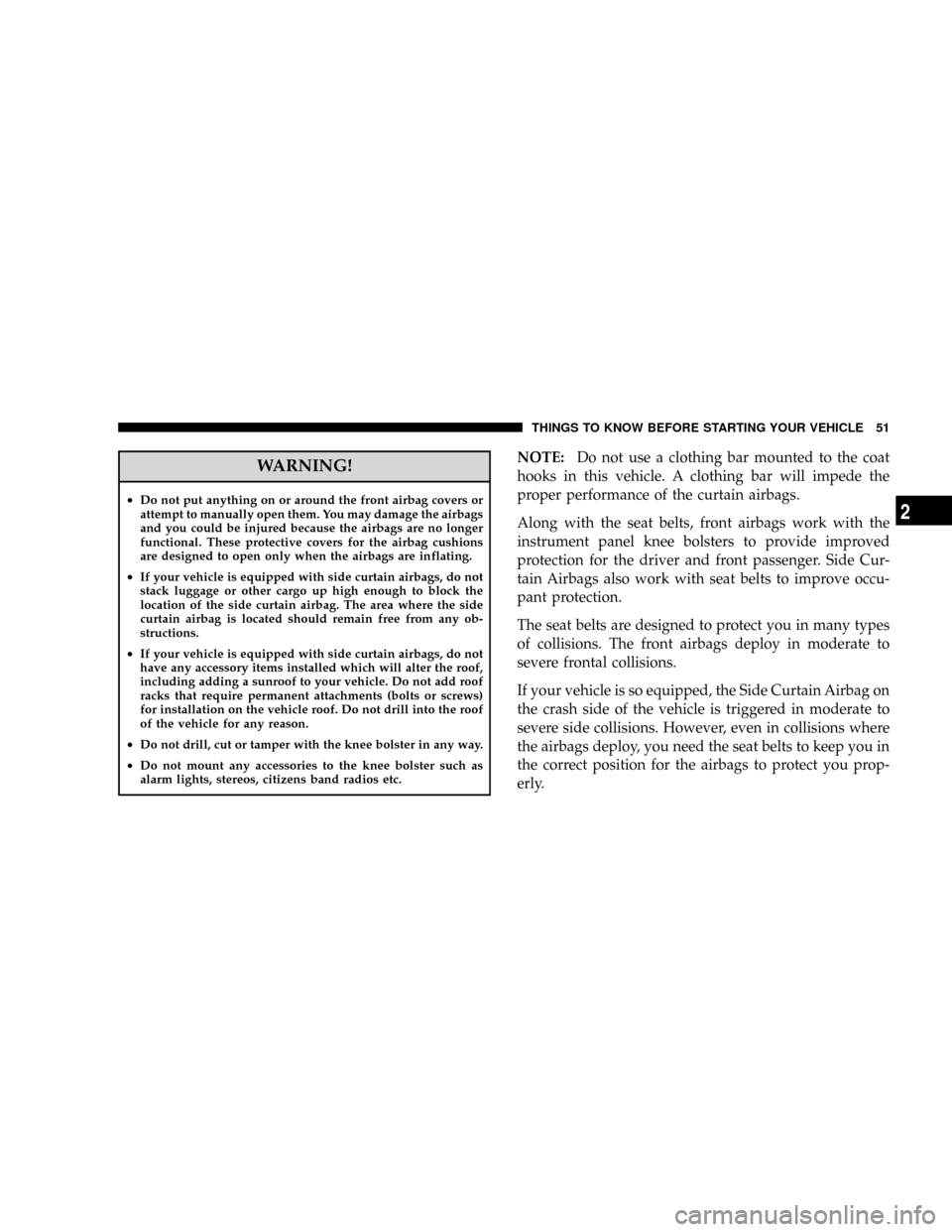
WARNING!
²Do not put anything on or around the front airbag covers or
attempt to manually open them. You may damage the airbags
and you could be injured because the airbags are no longer
functional. These protective covers for the airbag cushions
are designed to open only when the airbags are inflating.
²If your vehicle is equipped with side curtain airbags, do not
stack luggage or other cargo up high enough to block the
location of the side curtain airbag. The area where the side
curtain airbag is located should remain free from any ob-
structions.
²If your vehicle is equipped with side curtain airbags, do not
have any accessory items installed which will alter the roof,
including adding a sunroof to your vehicle. Do not add roof
racks that require permanent attachments (bolts or screws)
for installation on the vehicle roof. Do not drill into the roof
of the vehicle for any reason.
²Do not drill, cut or tamper with the knee bolster in any way.
²Do not mount any accessories to the knee bolster such as
alarm lights, stereos, citizens band radios etc.
NOTE:Do not use a clothing bar mounted to the coat
hooks in this vehicle. A clothing bar will impede the
proper performance of the curtain airbags.
Along with the seat belts, front airbags work with the
instrument panel knee bolsters to provide improved
protection for the driver and front passenger. Side Cur-
tain Airbags also work with seat belts to improve occu-
pant protection.
The seat belts are designed to protect you in many types
of collisions. The front airbags deploy in moderate to
severe frontal collisions.
If your vehicle is so equipped, the Side Curtain Airbag on
the crash side of the vehicle is triggered in moderate to
severe side collisions. However, even in collisions where
the airbags deploy, you need the seat belts to keep you in
the correct position for the airbags to protect you prop-
erly.
THINGS TO KNOW BEFORE STARTING YOUR VEHICLE 51
2
Page 54 of 440
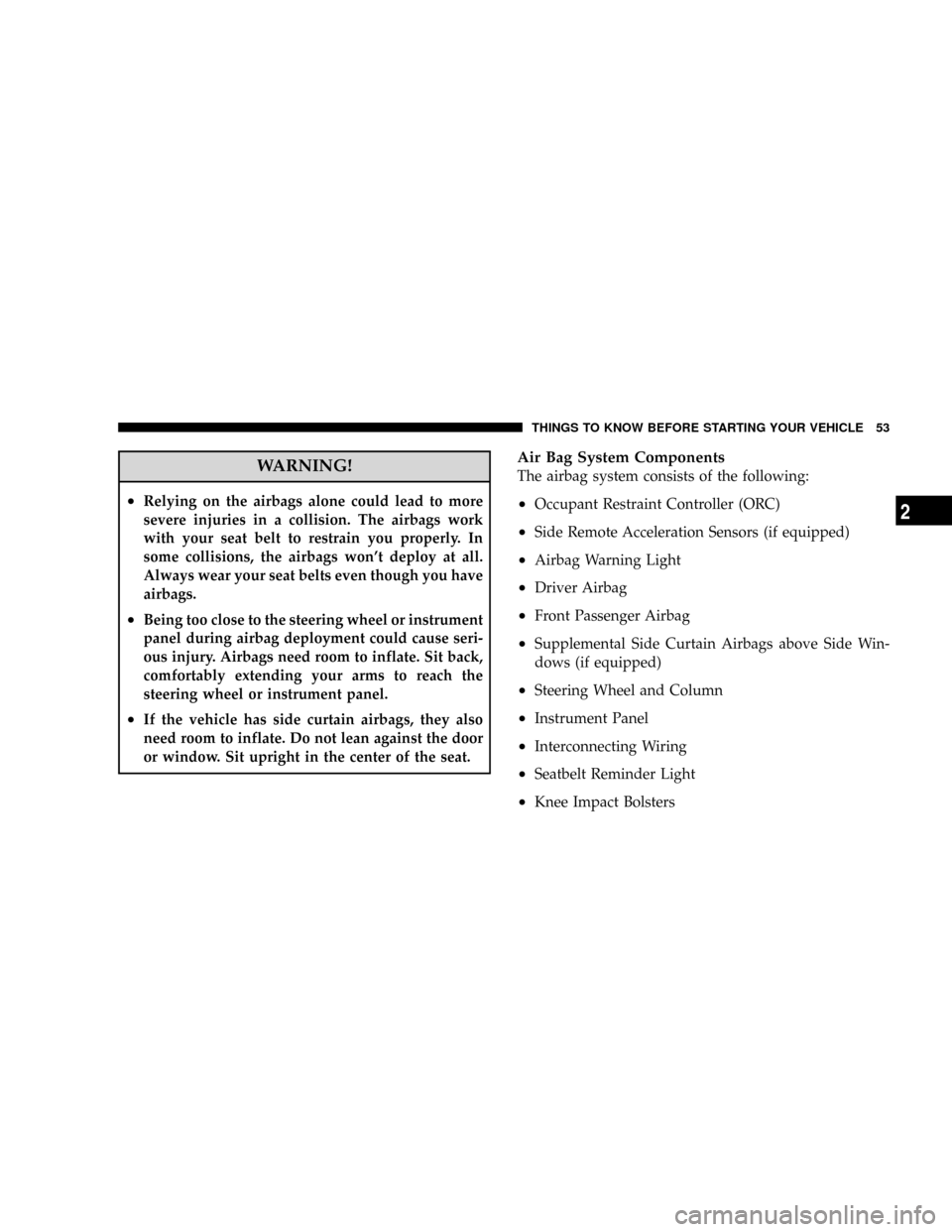
WARNING!
²Relying on the airbags alone could lead to more
severe injuries in a collision. The airbags work
with your seat belt to restrain you properly. In
some collisions, the airbags won't deploy at all.
Always wear your seat belts even though you have
airbags.
²Being too close to the steering wheel or instrument
panel during airbag deployment could cause seri-
ous injury. Airbags need room to inflate. Sit back,
comfortably extending your arms to reach the
steering wheel or instrument panel.
²If the vehicle has side curtain airbags, they also
need room to inflate. Do not lean against the door
or window. Sit upright in the center of the seat.
Air Bag System Components
The airbag system consists of the following:
²Occupant Restraint Controller (ORC)
²Side Remote Acceleration Sensors (if equipped)
²Airbag Warning Light
²Driver Airbag
²Front Passenger Airbag
²Supplemental Side Curtain Airbags above Side Win-
dows (if equipped)
²Steering Wheel and Column
²Instrument Panel
²Interconnecting Wiring
²Seatbelt Reminder Light
²Knee Impact Bolsters
THINGS TO KNOW BEFORE STARTING YOUR VEHICLE 53
2
Page 55 of 440
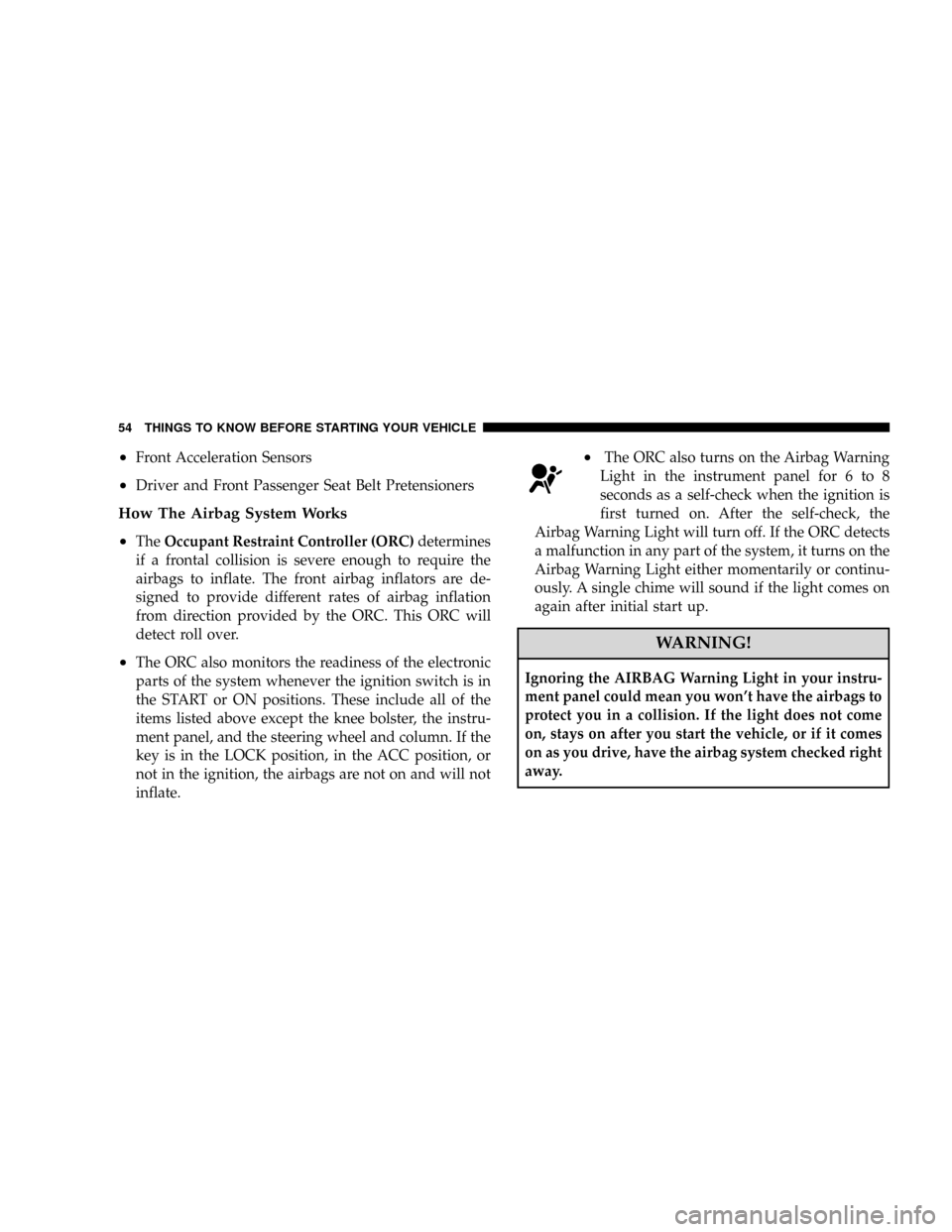
²Front Acceleration Sensors
²Driver and Front Passenger Seat Belt Pretensioners
How The Airbag System Works
²
TheOccupant Restraint Controller (ORC)determines
if a frontal collision is severe enough to require the
airbags to inflate. The front airbag inflators are de-
signed to provide different rates of airbag inflation
from direction provided by the ORC. This ORC will
detect roll over.
²The ORC also monitors the readiness of the electronic
parts of the system whenever the ignition switch is in
the START or ON positions. These include all of the
items listed above except the knee bolster, the instru-
ment panel, and the steering wheel and column. If the
key is in the LOCK position, in the ACC position, or
not in the ignition, the airbags are not on and will not
inflate.
²The ORC also turns on the Airbag Warning
Light in the instrument panel for 6 to 8
seconds as a self-check when the ignition is
first turned on. After the self-check, the
Airbag Warning Light will turn off. If the ORC detects
a malfunction in any part of the system, it turns on the
Airbag Warning Light either momentarily or continu-
ously. A single chime will sound if the light comes on
again after initial start up.
WARNING!
Ignoring the AIRBAG Warning Light in your instru-
ment panel could mean you won't have the airbags to
protect you in a collision. If the light does not come
on, stays on after you start the vehicle, or if it comes
on as you drive, have the airbag system checked right
away.
54 THINGS TO KNOW BEFORE STARTING YOUR VEHICLE
Page 56 of 440
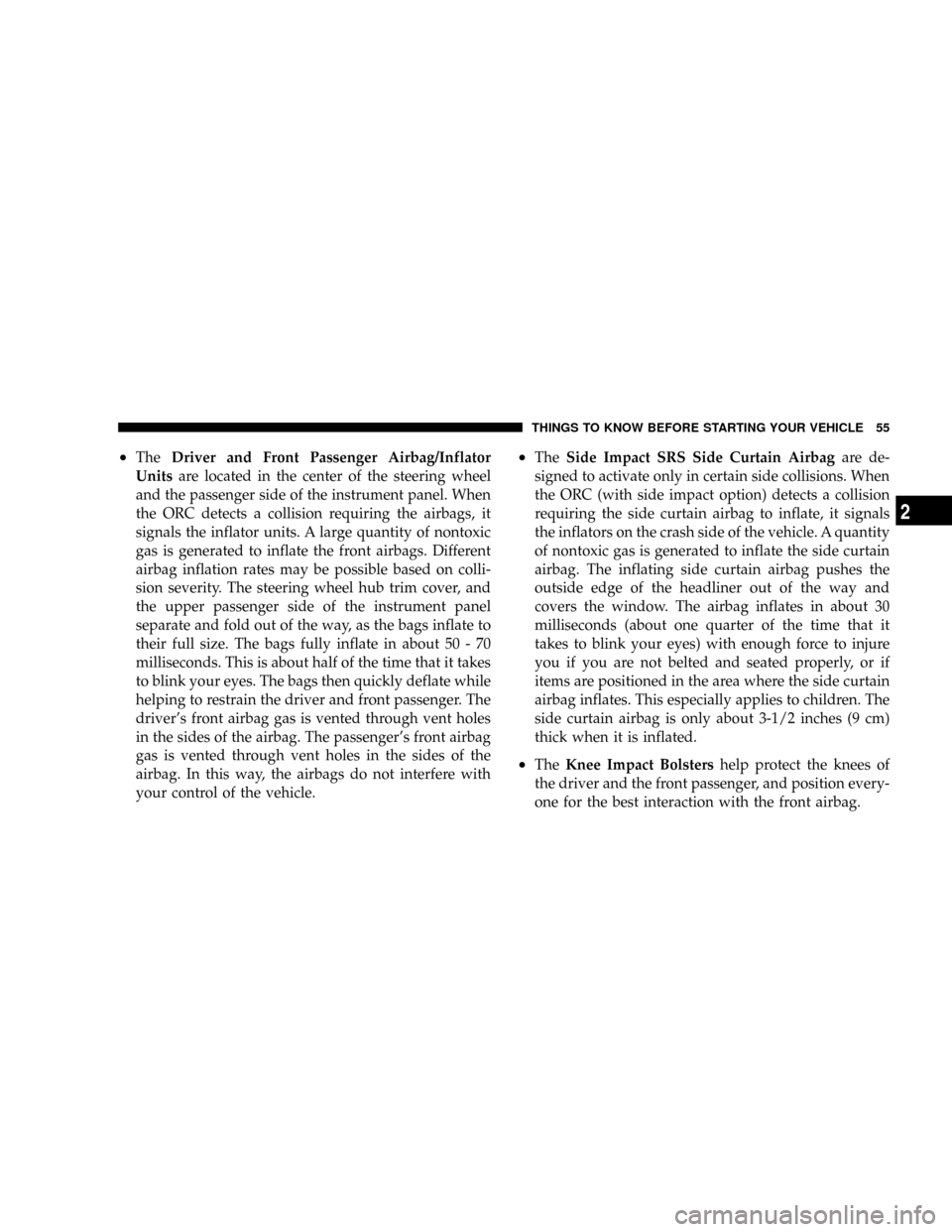
²TheDriver and Front Passenger Airbag/Inflator
Unitsare located in the center of the steering wheel
and the passenger side of the instrument panel. When
the ORC detects a collision requiring the airbags, it
signals the inflator units. A large quantity of nontoxic
gas is generated to inflate the front airbags. Different
airbag inflation rates may be possible based on colli-
sion severity. The steering wheel hub trim cover, and
the upper passenger side of the instrument panel
separate and fold out of the way, as the bags inflate to
their full size. The bags fully inflate in about 50 - 70
milliseconds. This is about half of the time that it takes
to blink your eyes. The bags then quickly deflate while
helping to restrain the driver and front passenger. The
driver's front airbag gas is vented through vent holes
in the sides of the airbag. The passenger's front airbag
gas is vented through vent holes in the sides of the
airbag. In this way, the airbags do not interfere with
your control of the vehicle.²TheSide Impact SRS Side Curtain Airbagare de-
signed to activate only in certain side collisions. When
the ORC (with side impact option) detects a collision
requiring the side curtain airbag to inflate, it signals
the inflators on the crash side of the vehicle. A quantity
of nontoxic gas is generated to inflate the side curtain
airbag. The inflating side curtain airbag pushes the
outside edge of the headliner out of the way and
covers the window. The airbag inflates in about 30
milliseconds (about one quarter of the time that it
takes to blink your eyes) with enough force to injure
you if you are not belted and seated properly, or if
items are positioned in the area where the side curtain
airbag inflates. This especially applies to children. The
side curtain airbag is only about 3-1/2 inches (9 cm)
thick when it is inflated.
²TheKnee Impact Bolstershelp protect the knees of
the driver and the front passenger, and position every-
one for the best interaction with the front airbag.
THINGS TO KNOW BEFORE STARTING YOUR VEHICLE 55
2
Page 58 of 440
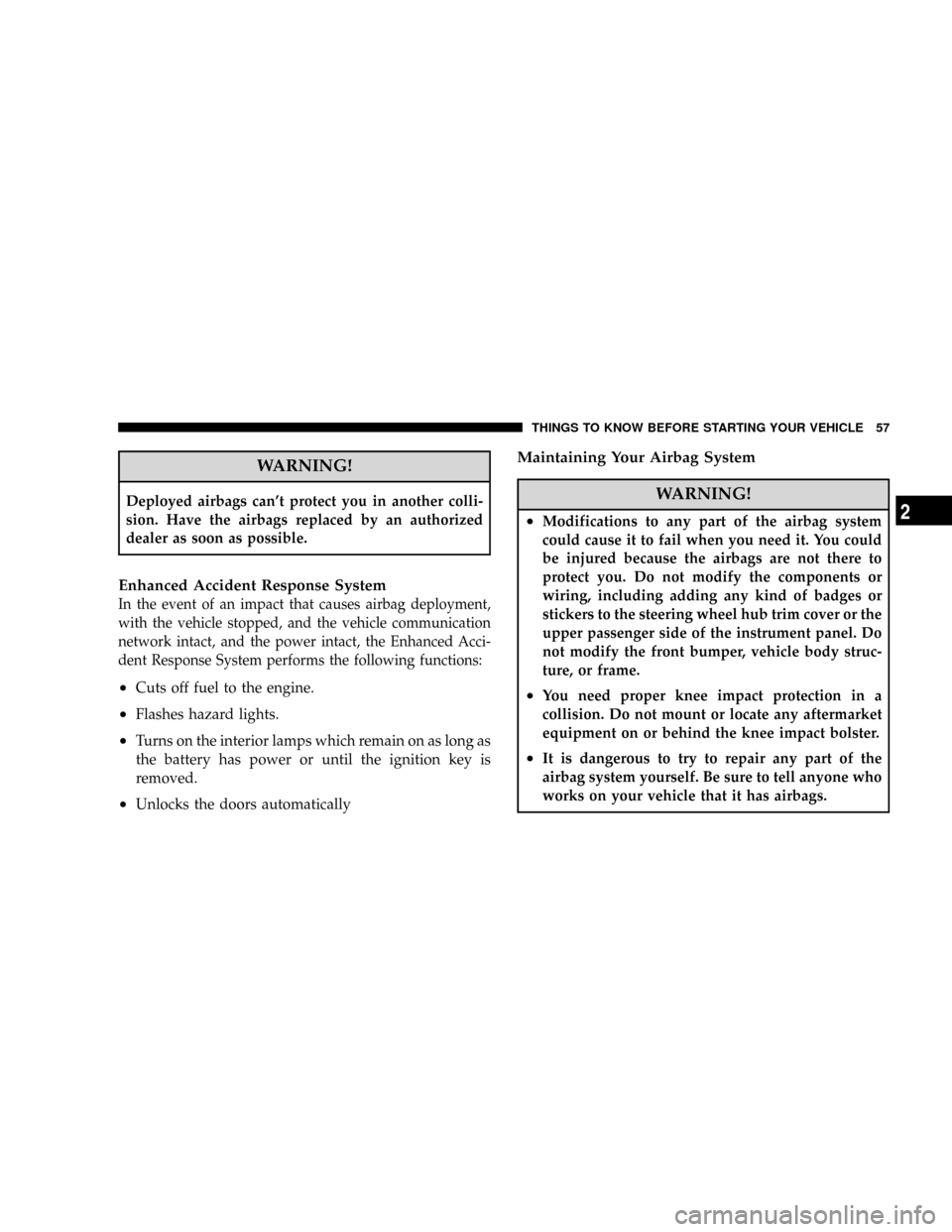
WARNING!
Deployed airbags can't protect you in another colli-
sion. Have the airbags replaced by an authorized
dealer as soon as possible.
Enhanced Accident Response System
In the event of an impact that causes airbag deployment,
with the vehicle stopped, and the vehicle communication
network intact, and the power intact, the Enhanced Acci-
dent Response System performs the following functions:
²Cuts off fuel to the engine.
²Flashes hazard lights.
²Turns on the interior lamps which remain on as long as
the battery has power or until the ignition key is
removed.
²Unlocks the doors automatically
Maintaining Your Airbag System
WARNING!
²Modifications to any part of the airbag system
could cause it to fail when you need it. You could
be injured because the airbags are not there to
protect you. Do not modify the components or
wiring, including adding any kind of badges or
stickers to the steering wheel hub trim cover or the
upper passenger side of the instrument panel. Do
not modify the front bumper, vehicle body struc-
ture, or frame.
²You need proper knee impact protection in a
collision. Do not mount or locate any aftermarket
equipment on or behind the knee impact bolster.
²It is dangerous to try to repair any part of the
airbag system yourself. Be sure to tell anyone who
works on your vehicle that it has airbags.
THINGS TO KNOW BEFORE STARTING YOUR VEHICLE 57
2
Page 72 of 440
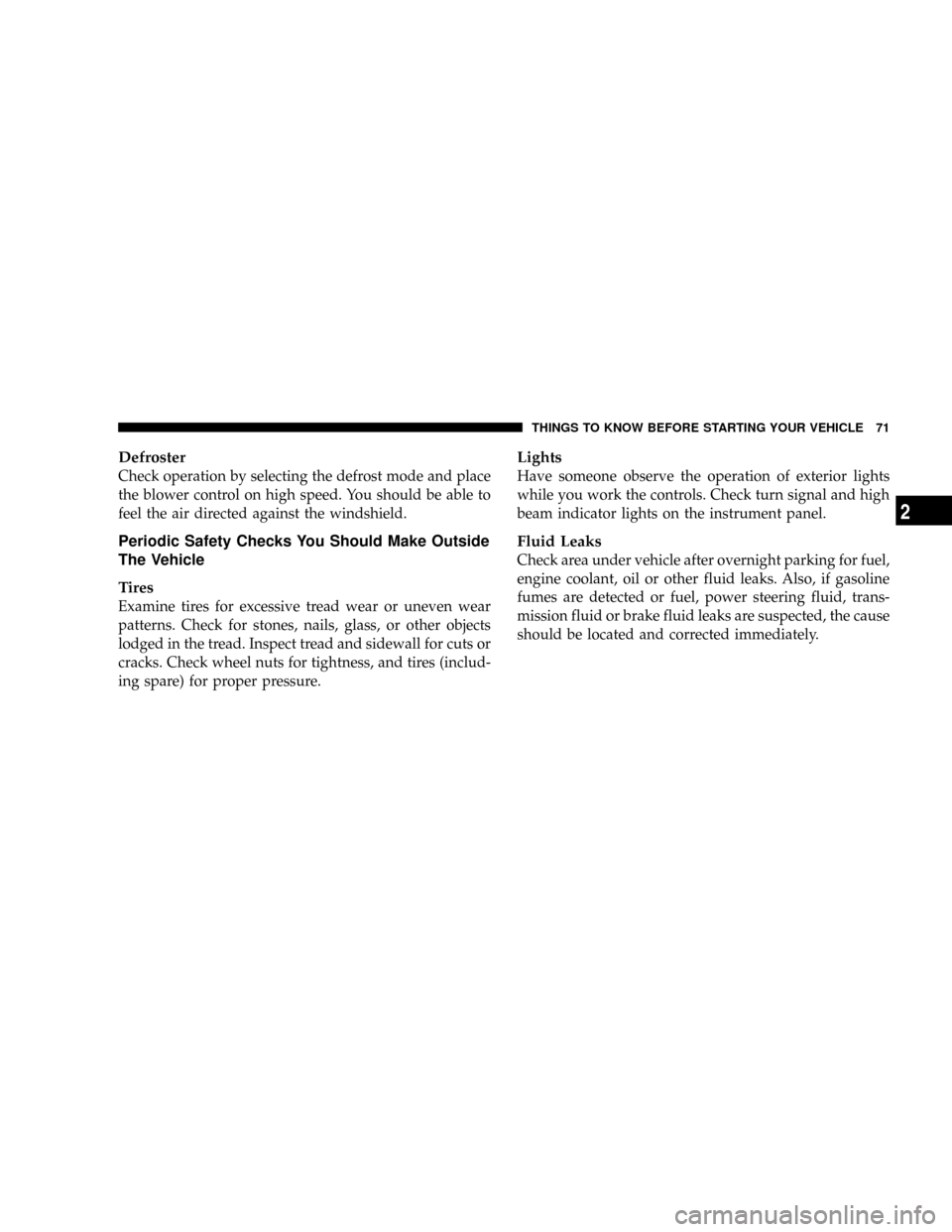
Defroster
Check operation by selecting the defrost mode and place
the blower control on high speed. You should be able to
feel the air directed against the windshield.
Periodic Safety Checks You Should Make Outside
The Vehicle
Tires
Examine tires for excessive tread wear or uneven wear
patterns. Check for stones, nails, glass, or other objects
lodged in the tread. Inspect tread and sidewall for cuts or
cracks. Check wheel nuts for tightness, and tires (includ-
ing spare) for proper pressure.
Lights
Have someone observe the operation of exterior lights
while you work the controls. Check turn signal and high
beam indicator lights on the instrument panel.
Fluid Leaks
Check area under vehicle after overnight parking for fuel,
engine coolant, oil or other fluid leaks. Also, if gasoline
fumes are detected or fuel, power steering fluid, trans-
mission fluid or brake fluid leaks are suspected, the cause
should be located and corrected immediately.
THINGS TO KNOW BEFORE STARTING YOUR VEHICLE 71
2
Page 75 of 440

NFront Seat Adjustment..................108
NManual Seat Height Adjustment Ð If
Equipped...........................109
NManual LumbarÐ If Equipped............109
NDriver's Seat Back Recline...............110
NAdjustable Head Restraints..............110
NHeated Seats Ð If Equipped.............111
NFold Flat Front Passenger Seat............113
NFolding Rear Seat.....................114
NReclining Rear Seat Ð If Equipped.........115
mTo Open And Close The Hood.............116
mLights...............................118
NMap/Reading Lights...................118NMulti-Function Control Lever.............119
NHeadlights, Parking Lights, Instrument Panel
Lights.............................119
NLights-On Reminder...................120
NFog Lights Ð If Equipped...............121
NTurn Signals.........................121
NHighbeam/Lowbeam Select Switch.........122
NPassing Light........................123
mDaytime Running Lights (DRL) Ð If Equipped . . 123
NFunctionality........................123
mWindshield Wipers And Washers...........123
NWindshield Washers...................123
NMist Feature.........................124
74 UNDERSTANDING THE FEATURES OF YOUR VEHICLE